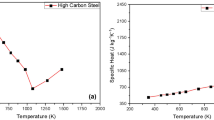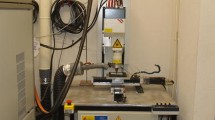Abstract
In order to optimize the laser–tungsten inert arc (TIG) welding process of cemented carbide to steel, a novel combined model consisting of circular disk source, line source, and double ellipsoidal TIG heat source was put forward to simulate the deep penetration phenomena and bead profile. In contrast, laser heat source model was validated using macrostructure analysis results. The effects of the circular disk of radius and the material properties on the bead profile were discussed. For mechanism surface formation, surface depression or humps was discussed based on the high-speed photography technique to verify bead profile characterization. The results manifested that in the model, the circular disk radius played a key role in the formation of bead profile. And the penetration coefficient chiefly affected the root of weld and the keyhole formation. During the hybrid welding, the main forces influencing the surface depression or humping were intrinsic stress from coefficient of thermal expansion gradient, surface tension, buoyancy force, stirring action, and shock waves at the end of the keyhole. Before the solidification of the upper part of the melt, the melt was driven by the fluctuated plasma, plumes, or other forces. While the amount of melt filling the back welds metal of keyhole was larger than that caused by plume losses and the shrinkage of weld metal, the humps came into being.
Similar content being viewed by others
References
Valente RAF, Jorge RMN, Roque AP, Parente MPL, Fernandes AA (2008) Simulation of dissimilar tailor-welded tubular hydroforming processes using EAS-based solid finite elements. Int J Adv Manuf Technol 37:670–689. doi:10.1007/s00170-007-1015-y(7-8)
Mackwood AP, Crafer RC (2005) Thermal modeling of laser welding and related processes: a literature review. Opt Laser Technol 37:99–115
Rohde M, Markert C, Pfleging W (2010) Laser micro-welding of aluminum alloys: experimental studies and numerical modeling. Int J Adv Manuf Technol. doi:10.1007/s00170-009-2510-0
Bag S, Trivedi A, De A (2008) Use of a multivariate optimization algorithm to develop a self-consistent numerical heat transfer model for laser spot welding. Int J Adv Manuf Technol 38:575–585. doi:10.1007/s00170-007-1101-1
Liu LM, Qi XD (2010) Strengthening effect of nickel and copper interlayers on hybrid laser–TIG welded joints between magnesium alloy and mild steel. Mater Des 31:3960–3963
Xu PQ, Zhao XJ (2010) Analysis of microstructure and properties of cemented carbide and invar alloy weldment. J Mater Eng Perform 19:294–300
Barbatti C, Garcia J, Liedl G, Pyzalla A (2007) Joining of cemented carbides to steel by laser beam welding. Materialwiss Werkstofftech 38:907–914. doi:10.1002/mawe.200700196
Costa A, Miranda RM, Quintino L (2006) Materials behavior in laser welding of hardmetals to steel. Mater Manuf Process 21:459–465
Taha-al ZY, Hashmi MS, Yilbas BS (2009) Effect of WC on the residual stress in the laser treated HVOF coating. J Mater Process Tech 209:3172–3181
Bag S, Trivedi A, Dea A (2009) Development of a finite element based heat transfer model for conduction mode laser spot welding process using an adaptive volumetric heat source. Int J Therm Sci 48(10):1923–1931. doi:10.1016/j.ijthermalsci.2009.02.010
Zimmer S, Langlois L, Laye J, Bigot R (2010) Experimental investigation of the influence of the FSW plunge processing parameters on the maximum generated force and torque. Int J Adv Manuf Technol 47(1–4):201–215
Lankalapalli KN, Tu JF, Leong KH, Gartner M (1999) Laser weld penetration estimation using temperature measurements. J Manuf Sci Eng-Trans ASME 121:179–188
Xu PQ, Huang C, He JP (2009) Study on temperature field for invar alloy during TIG welding. Int J Adv Manuf Technol 42:40–50
Komanduri R, Hou ZB (2001) Thermal analysis of the arc welding process: part II. Effect of variation of thermophysical properties with temperature. Metall Mater Trans B Process Metall Mater Process Sci 32:483–499
Shanmugam NS, Buvanashekaran G, Sankaranarayanasamy K, Manonmani K (2009) Some studies on temperature profiles in AISI 304 stainless steel sheet during laser beam welding using FE simulation. Int J Adv Manuf Technol 43(1–2):78–94
Rosenthal D (1946) The theory of moving sources of heat and its application to metal treatments. Trans Amer Soc Mech Eng 68:849–866
Lax M (1977) Temperature rise induced by a laser beam. J Appl Phys 48:3919–3924
Miyazaki T, Giedt WH (1982) Heat transfer from an elliptical cylinder moving through an infinite plate applied to electron-beam welding. Int J Heat Mass Transfer 25:807–814
Steen WM, Dowden J, Davis M, Kapadia P (1988) A point and line source model of laser keyhole welding. J Phys D 21:1255–1260
Kazemi K, Goldak JA (2009) Numerical simulation of laser full penetration welding. Comp Mater Sci 44:841–849
Nonn A, Dahl W, Bleck W (2008) Numerical modelling of damage behaviour of laser-hybrid welds. Eng Fract Mech 75:3251–3263
Doi M (2010) Coaxial hybrid process of hollow cathode TIG and YAG laser welding. Weld Int 24(3):188–196. doi:10.1080/09507110902843131
Ribic B, Rai R, DebRoy T (2008) Numerical simulation of heat transfer and fluid flow in GTA/Laser hybrid welding. Sci Technol Weld Joi 13(8):683–693
Ribic BD, Rai R, Palmer TA, Debroy T (2009) Arc–laser interactions and heat transfer and fluid flow in hybrid welding. Trends in Welding Research, Proceedings of the 8th International Conference, pp 313–320. doi:10.1361/cp2008twr313
Hussein NIS, Pashby IR, McCartney DG (2009) Laser and arc weld methods for direct metal deposition of Waspaloy. Int J Manuf Tech Manag 17(4):419–425
Zhang TH, Xiao TY, Yang BR (2008) The process simulation of virtual laser surface hardening. Int J Adv Manuf Tech 37:690–697
Bhushan B, Gupta BK (1991) Handbook of tribology. McGraw-Hill, New York
Zhang YH (2007) Welding mechanics and structural integrity principle. Beihang University Press, Beijing
He X, Fuerschbach PW, DebRoy T (2003) Heat transfer and fluid flow during laser spot welding of 304 stainless steel. J Phys D Appl Phys 36:1388–1398
Xu PQ (2010) Dissimilar welding of WC–Co cemented carbide to Ni42Fe50.9C0.6Mn3.5Nb3 invar alloy by laser–tungsten inert gas hybrid welding. Mater Design. doi:10.1016/j.matdes.2010.06.006
Xu PQ, Yao S, He JP, Ma CW, Ren JW (2009) Numerical analysis for effect of process parameters of low current micro-PAW on constricted arc appearance. Int J Adv Manuf Tech 44:255–264
Gratzke U, Kapadia PD, Dowden J, Kroos J, Simon G (1992) Theoretical approach to the humping phenomenon in welding process. J Phys D 25:1640–1647
Huang ZQ, He YH, Wu CH, Zhang LJ, Xiao YF, Huang BY (2009) Theoretical calculation and numerical simulation for thermal residual stresses of cemented carbides. Rare Met Mat Eng 38:303–307
Dowden J, Wu SC, Kapadia P, Strange C (1991) Dynamics of the vapour flow in the keyhole in penetration welding with a laser at medium welding speeds. J Phys D 24:519–532
Wu CS, Wang HL, Zhang YM (2009) Numerical analysis of the temperature profiles and weld dimension in high power direct-diode laser welding. Comp Mater Sci 46:49–56
Seto N, Katayama S, Matsunawa A (1999) A high-speed simultaneous observation of plasma and keyhole behavior during high power CO2 laser welding. Proceedings of ICALEO Sec. E, pp 17–19
Honda H, Tsukamoto S, Kawaguchi I, Arakane G (2010) Keyhole behavior in deep penetration CO2 laser welding. J Laser Appl 22:43–47
Fabbro R, Chouf K (2000) Dynamical description of the keyhole in deep penetration laser welding. J Laser Appl 12(4):142–148
Lee JY, Ko SH, Farson DF, Yoo CD (2002) Mechanism of keyhole formation and stability in stationary laser welding. J Phys D: Appl Phys 35:1570–1576
Klein T, Vicanek M, Simon G (1996) Forced oscillations of the keyhole in penetration laser beam welding. J Phys D Appl Phys 29:322–332
Geiger M, Leitz KH, Koch H, Otto A (2009) A 3D transient model of keyhole and melt pool dynamics in laser beam welding applied to the joining of zinc coated sheets. Prod Eng 3:127–136
Author information
Authors and Affiliations
Corresponding author
Electronic supplementary material
Below is the link to the electronic supplementary material.
ESM 1
(OPJ 33 kb)
Rights and permissions
About this article
Cite this article
Xu, Pq., Bao, Cm., Lu, Fg. et al. Numerical simulation of laser–tungsten inert arc deep penetration welding between WC–Co cemented carbide and invar alloys. Int J Adv Manuf Technol 53, 1049–1062 (2011). https://doi.org/10.1007/s00170-010-2898-6
Received:
Accepted:
Published:
Issue Date:
DOI: https://doi.org/10.1007/s00170-010-2898-6




